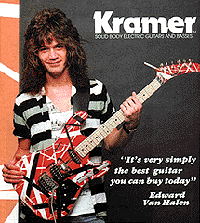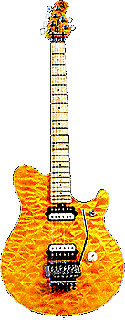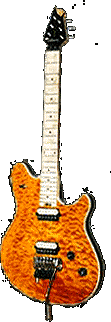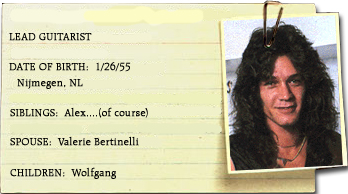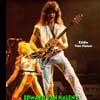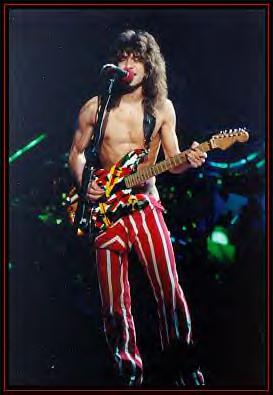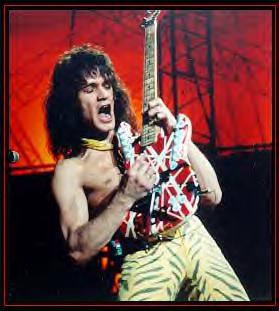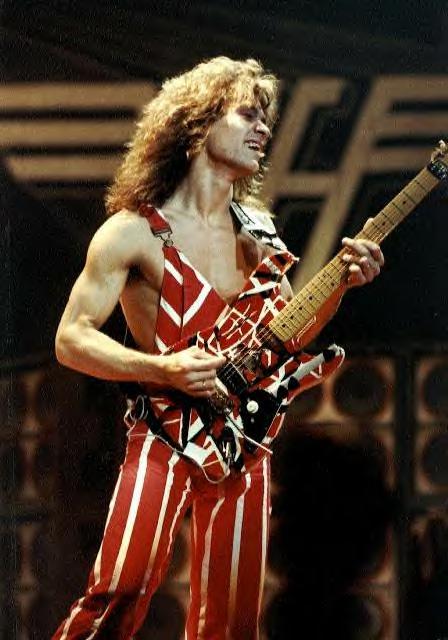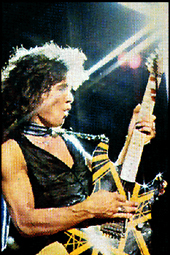 With their 1978 eponymous debut, Van Halen simultaneously re-wrote the rules for rock guitar and hard rock in general. Guitarist Eddie Van Halen redefined what electric guitar could do, developing a blindingly fast technique with a variety of self-taught two-handed tapping, hammer-ons, pull-offs, and effects that mimicked the sound of machines and animals. It was wildly inventive and over-the-top, equaled only by vocalist David Lee Roth, who brought the role of a metal singer to near performance art standards. Together, they made Van Halen into the most popular American rock & roll band of the late '70s and early '80s, and, in the process, set the template for hard-rock and heavy metal for the '80s. Throughout the '80s, it was impossible not to hear Van Halen's instrumental technique on records that ranged from the heaviest metal to soft-pop.
With their 1978 eponymous debut, Van Halen simultaneously re-wrote the rules for rock guitar and hard rock in general. Guitarist Eddie Van Halen redefined what electric guitar could do, developing a blindingly fast technique with a variety of self-taught two-handed tapping, hammer-ons, pull-offs, and effects that mimicked the sound of machines and animals. It was wildly inventive and over-the-top, equaled only by vocalist David Lee Roth, who brought the role of a metal singer to near performance art standards. Together, they made Van Halen into the most popular American rock & roll band of the late '70s and early '80s, and, in the process, set the template for hard-rock and heavy metal for the '80s. Throughout the '80s, it was impossible not to hear Van Halen's instrumental technique on records that ranged from the heaviest metal to soft-pop. Through all the upheaval over lead vocalists, Eddie Van Halen and his prodigious talent remained at the core of Van Halen. The son of a Dutch bandleader, Eddie and his family moved from the Netherlands to Pasadena, California in 1967, when he was 12 years old and his older brother Alex was 14. As their father supported the family by playing in wedding bands, Eddie and Alex continued their classical piano training. Soon, both boys were enraptured by rock & roll. Eddie learned how to play drums and Alex took up the guitar, eventually switching instruments. The brothers began a hard-rock band called Mammoth and began playing around Pasadena, eventually meeting David Lee Roth. At the time, Roth, who had been raised in a wealthy Californian family, was singing in Redball Jet. Impressed by the Van Halen brothers, he joined forces with the group. Shortly afterward, bassist Michael Anthony, who was singing with Snake, became a member of Mammoth.
Eddie Van Halen became a role model for modern guitarists, regardless of their tastes and preferences. His talent and skill were unquestioned, and he demonstrated a dazzling array of techniques, from simple riffs to extended solos filled with intricate fret work. "Eruption," an instrumental track on the first album, became his calling card as it was transformed into a lengthy showcase during concerts.
A Mammoth Beginning:
Brothers Alex and Eddie Van Halen were born in The Netherlands. After the family moved to Pasadena, California Eddie began studying classical piano and Alex took up the guitar. By their early teens, it was Eddie who was playing guitar and Alex had switched to drums.
In 1974, the Van Halen brothers, bassist Michael Anthony and vocalist David Lee Roth began playing local gigs as Mammoth. When they discovered that another Pasadena band was already using that name, Roth suggested the 
group take the name Van Halen. The brothers didn’t like it at first, but when no one came up with a better name, they went along with it. Launching the Rocket:
In 1976, Van Halen was getting regular work playing clubs on Los Angeles’ Sunset Strip. It was here that they came to the attention of KISS frontman Gene Simmons, who wa s so impressed with the band that he paid for their first demo tape. In 1978, their self-titled debut album was released, becoming one of the most successful debut albums ever and bringing hard rock into the musical mainstream. Over the next 20 years, the Van Halens and Anthony remained the core of the increasingly influential and successful band. Roth left the group in 1985, primarily because of disagreements with Eddie Van Halen. Sammy Hagar, then the lead singer for Montrose, replaced Roth. The “Van Hagar” era lasted until 1996. Gary Cherone signed on for two years, and one album, as lead singer. Hagar rejoined the band for a reunion tour in 2004.
Today and Tomorrow:
Roth and Hagar have pursued successful solo careers, and toured together in 2002. Hagar and Anthony teamed up for a 2006 summer tour. Until recently Eddie Van Halen has been somewhat reclusive, undergoing hip replacement and cancer surgery, and a divorce from his wife of 21 years, actress Valerie Bertinelli. The brothers performed briefly with country artist Kenny 
Chesney during a Los Angeles area concert in June 2006. Eddie performed a solo concert in Los Angeles in July 2006. The Roth era brought the greatest critical acclaim, though the Hagar era was the most successful commercially. In 2007, the Van Halen brothers, Eddie's son Wolfgang and Roth re-formed Van Halen for a reunion tour.
Edward bought the ash body from Linn Ellsworth in 1975 for fifty dollars and the neck (also a cast-off) for eighty dollars. Originally, the body came with single-coil bridge, neck, and middle pickup positions pre-routed and Van Halen, with a chisel, excavated a hole to house a humbucker in the bridge position. He placed in this chiseled hole a P.A.F. from a 1961 Gibson ES-335. The pickup was also "ruined" but sounded good so it's what he used. The single-coil neck pick-up was completely disengaged. The guitar was first sprayed with black and then white Scwinn acrylic lacquer bicycle paint and mounted a black strat-style pickguard (also home-made) eventually only covering the two front (electronics) routings. The Guitar was eventually repainted with red, black and white stripes and orange truck reflectors added to the back of the guitar.. This red-Frankenstrat first appeared as the black and white guitar pictured on the debut VH album The nut was brass and the tailpiece unit was from a 1961 Fender Stratocaster. This guitar was Edward's main instrument for the first several albums and tours. During the band's second world wide stampede Van Halen replaced the original tremelo with then-prototype Floyd Rose. A quarter was attached just under the top-back side of the floyd Rose to keep it from rising up.That first Linn Ellsworth neck was broken by the guitarist's rigorous stage antics and replaced with whatever was handy (including a Danelectro at one point). The Ellsworth neck sported Gibson jumbo frets ("I put those in with the help of some Crazy Glue"-EVH). The tuning heads were Schallers. "There's really no secret. The reason I use what I use is through trial and error,"-EVH




